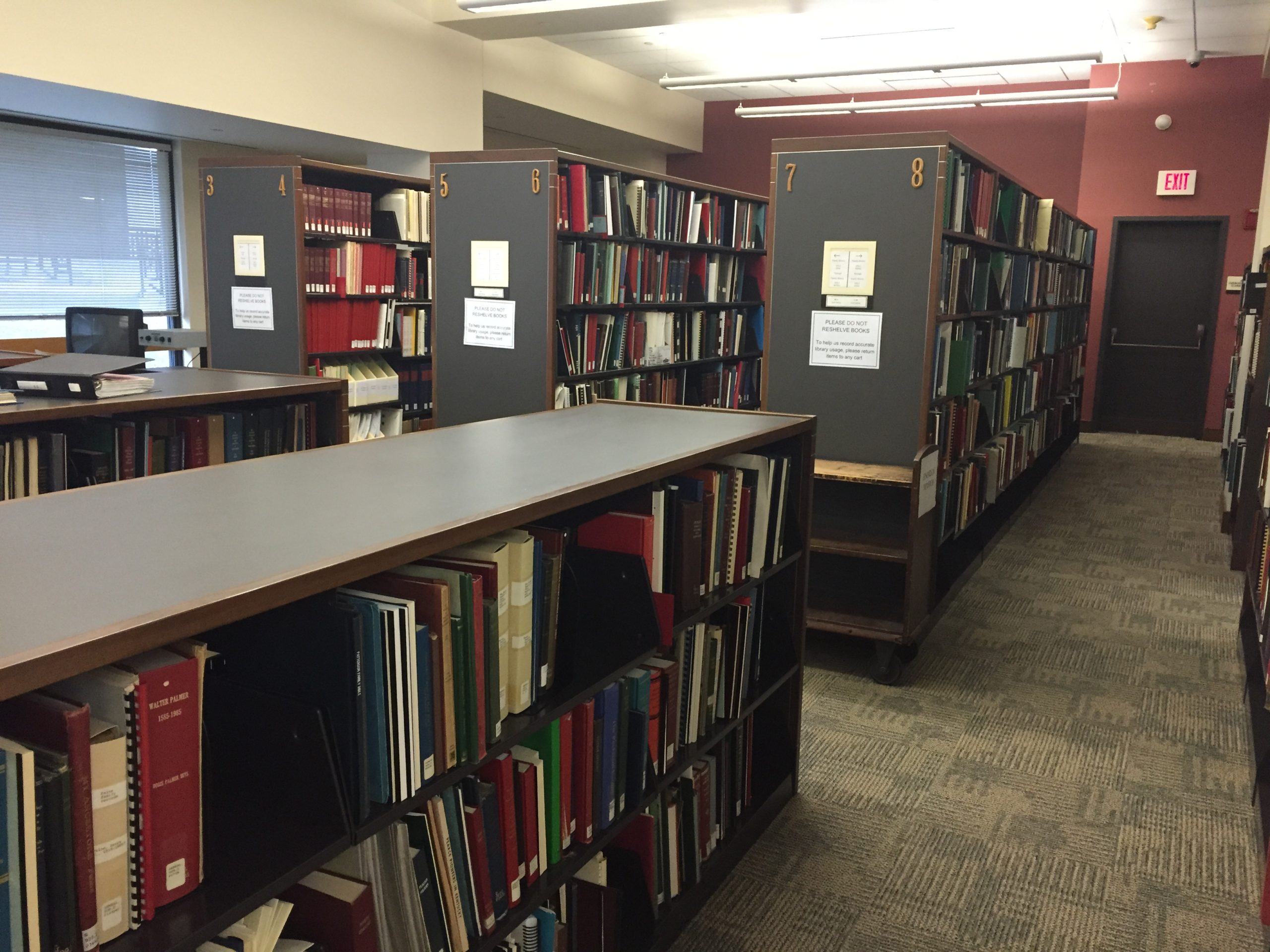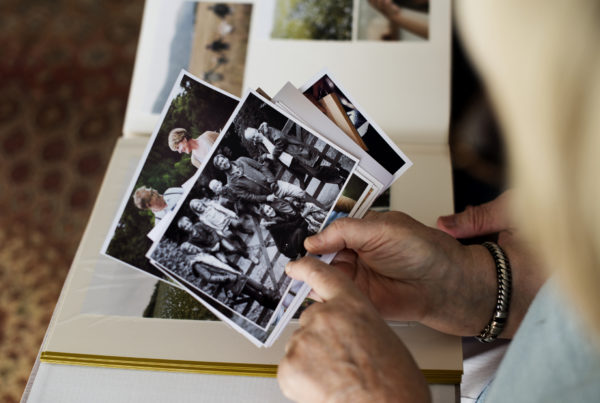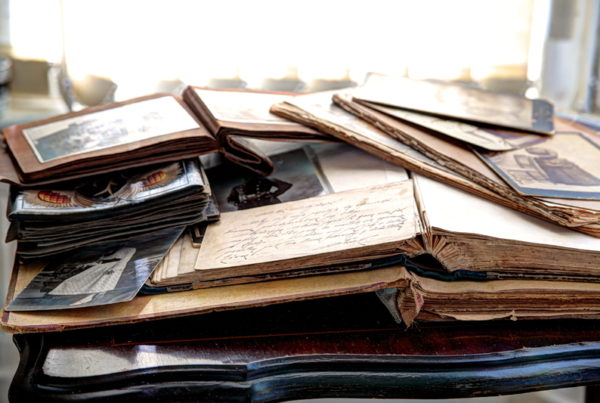The Indiana State Library is very near and dear to my heart. As the genealogist for The Society of Indiana Pioneers, we are fortunate enough to have our office located within the Genealogy Section of the ISL on the first floor. As I said last week, I am so lucky to be able to have access to all the books, computer databases, family and county files whenever I need them.
In this article, I would like to cover some of the things that lure me up to the second floor of the State Library almost every time I go.
My top 5 reasons to visit just the Indiana Collections Section (2nd floor) of the Indiana State Library are:
- Newspapers on microfilm by county
- County Records (Marriage, Probate, and Land Records) on microfilm
- County Histories
- City Directories
- Biography Index
Newspapers on microfilm
Newspapers are the window into the world that our ancestors lived in and are an incredible resource to us as family history researchers. The first thing that I think all researchers think of when it comes to newspapers are the obituaries, death notices and marriage articles. This is a pretty strong enough reason, but as you look for those obituaries, take a minute to read some of the articles or sections on the township that your relative lived in and the headlines for the day to get a flavor for what was going on in the area!
Where do you get started? You need to know what county and hopefully what city your ancestor lived in so that you can check to see what is available. You can click on THIS (and scroll down) to go to the index of newspapers that the ISL has by each county. It is worth the time to look at the index since it will quickly tell you if the library has the date(s) that you need. If there wasn’t a newspaper in your ancestor’s particular town, then I would go to the county newspaper or the newspaper where the county seat is located.
Here’s a tip: Always start with the day that your ancestor passed away if you know it. Some newspapers took information up until they printed the paper and might have added a death if it occurred early in the day. Then I keep checking for several days after the death date when looking for the obituary. There are times that it might take a week to show up. You will want to also look at the township “chatter” sections because they might give you some information concerning the death or family that came into town visiting, etc.
The microfilm readers are a little tricky to get used to so don’t hesitate to ask one of the very helpful librarians to get you started. I have my favorite ones to use which is pretty common! As far as retrieving a copy, you have several options as well. They do have local printers and you pay on the honor system to the librarian when you are done. You are allowed to bring USB drives and plug them into the computers to save your images to take home with you and they can also be emailed as well. Of course, you can also do like I do and take pics with my camera. I like the ease of being able to take the image back with me and not fuss with any of the computers at the library. Just the microfilm machine and me… Again, it all gets back to what you are comfortable with so don’t hesitate to try different things while you are there to see what fits best for you.
 County Records on Microfilm
County Records on Microfilm
My next favorite section is the County records on microfilm and I do spend a lot of time in this area. You can find an index of what all is available HERE. When I am looking for a document that ties generations together, I always head to the Wills, Probate and Estate Records first. It helps to have a general idea of when your ancestor passed away so you can narrow down your research time-frame. As you can see by the picture, each county record is clearly labeled by county and then by section such as wills or marriages.
One tip: The drawers in these types of cabinets can be a bit finicky so you need to make sure that all the drawers are shut in order to open one up. There are times that I will find a drawer with just a little bit open and it will keep the rest of the file drawers from opening. Sounds silly but you wait until you are standing there desperately trying to get a drawer open and you’ll thank me for this tip!
Indexes are the key to microfilmed records. The WPA Marriage books by county can lead you to the Volume number and page to locate a marriage record. Just a reminder that these are not the fancy marriage records that you might find framed on a wall, but they are the records that are made at the county recorder’s office. Just the facts, thank you!
You will quickly see that there might be more than one volume (or copied book) listed on the microfilm. I find that if I need to go to the 2nd or 3rd volume that I can do a quick fast-forward and watch the screen for a black space to come up. It doesn’t last long, so you definitely have to keep your eyes focused (or slightly unfocused but still gazing towards the screen.) I say unfocused since I get a little dizzy watching the screen whirl by me too fast – but that is just me! If I need to go to the third volume on a microfilm, then I will watch for the 3rd black space and quickly stop. It usually takes just a quick adjustment to check the label and make sure that I have reached the correct volume.
For the most part, you will find indexes in the front of the microfilm section but I have also found them at the back. There are also volumes that are simply indexes. Sometimes they cover many decades and you will have to just move through the microfilm until you reach the alphabet letter you are looking for. Each indexing system can be a little different and can range from simply all the “A’s” listed on one page, etc. to a more complicated system.
I might also suggest that you check down in the county section of the Genealogy Library on the first floor to see if there are any marriage, land or will indexes already printed. That is a huge help. I do recommend that you go ahead and get the a copy of the original though, because the transcribed or indexed information is only as good as the transcriber! As they used to say in my computer courses in college – “Garbage in, Garbage out!”
Indianapolis Newspaper Index
There is really so much to say about all the sections, that it would take a short booklet to cover it all. The Indianapolis Newspaper Index can be found in the “old-fashioned” catalog cabinets that is located right by the librarian’s desk near the microfilm. If you have any Indianapolis ancestors or ancestors that might have been written up in Indianapolis newspapers, it would be worth a look. You can find an online index HERE as well, but if you are in the library, I suggest actually letting your fingers do the walking! When I use these card files, I think of dedicated librarians laboriously typing up each card noting a name and the newspaper information such as date, page, and brief description. Some of the cards were actually typed up by the WPA workers. But the sheer dedication to the task at hand is quite unfathomable to me, someone used to using NewspaperArchive and OCR scanning. But as of this time, these particular Indinapolis newspapers have not all been digitized for OCR so this is a resource that I always hope that I can have an excuse to use!
Then you can simply head over to the Indianapolis newspapers on microfilm and easily locate the article you found. Oh, I love indexes!
Indiana Biographies
There are also indexed card files for Indiana Biographies located on the 1st floor on the east side of the library in the Grand Hall pretty much by itself. You will know you are in the right place because of the stained-glass. You can find them online HERE but it is fun to actually sift through the cards! Once you have located the book title, write down all the information and take it to the librarian at by the top of the 2nd floor stairs. They are located by the north facing windows and are more than happy to retrieve the book that you have located. These books are located in closed stacks so a librarian will need to retrieve them for you.
City Directories
And don’t forget the City Directories and County Histories that are also available on the 2nd floor. Being able to locate your ancestor in a city directory can help to zoom in on when an ancestor passed away or or where they lived and what their occupations were from year to year. You can find the listing by county HERE.
County Histories
The County histories are so very interesting once you understand that the biographies that they sometimes hold were given by family members that paid to have their own biography printed. So, when a lineage society suggests that you can’t always use a county history for proof, you really can’t fault them. Many times I have found that a family member gave faulty information either by mistake or on purpose to bolster their family’s history a bit! But, they are invaluable since sometimes the history was taken during the lifetime of the pioneer ancestor and this means that most, if not all of the information, is pretty close to the truth. Once you have a biography found in a county history, then backing it up with extra documentation to bolster it just might be enough to make a circumstantial case. Never give up! You can find a directory of available County Histories HERE.
Whew… I am exhausted from these two articles on the Indiana State Library. While you might not have ancestors that came from our state, it is good to know that if our state library carries information on other states, then most likely other state libraries will be very similar. I haven’t even touched on the Manuscripts and Rare Books area along with so many more great places to do some family history hunting! Take some time and browse around the ISL website. Make yourself at home! I certainly hope that it makes you think that if you haven’t crossed the threshold of a library lately, either local or state, that it might be a good time for a roadtrip!








